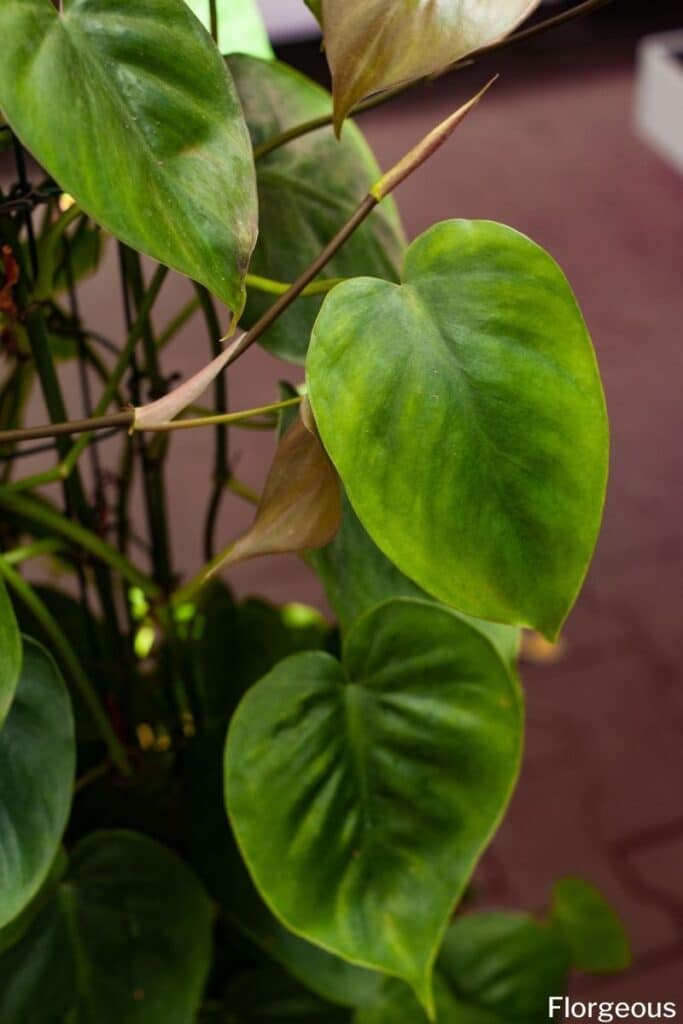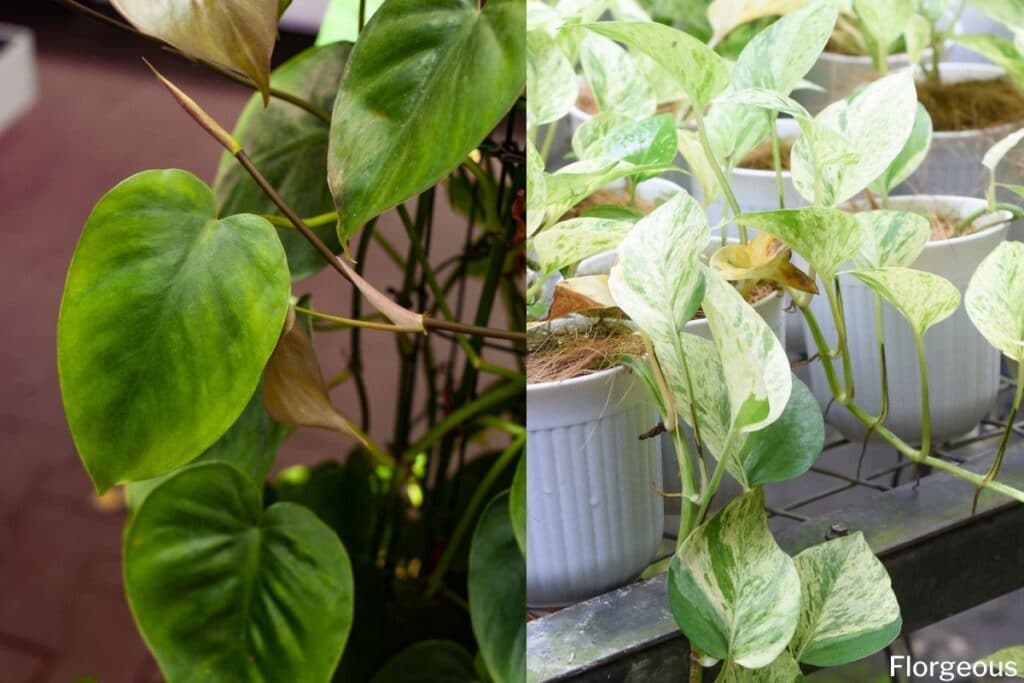You might be wondering, what’s the difference between devil’s ivy and philodendron? Though they are both common houseplants, they are not one and the same – it is important to be able to tell the difference between pothos vs. philodendron if you plan on growing either in your home.
At first glance, it’s quite easy for a novice gardener to confuse a pothos and a heartleaf philodendron. Both plants have glossy, green, heart-shaped foliage that is quite attractive, along with a trailing habit that makes both perfectly suited for growing in a hanging container or on a trellis.
However, there are some distinct differences between the two types of plants as well. Here’s what you need to know.
What is the Difference Between Pothos and Philodendron?
Both the philodendron and pothos plants come from the Araceae family. However, pothos is a member of the Epipremnum genus while philodendron belongs to the Philodendron genus.
Most pothos plants that we grow in our homes are part of the Epipremnum aureum species, including neon, jade, and golden pothos.

Philodendron species typically belong to philodendron hederaceum. This includes the classic green heartleaf philodendron along with philodendron Brasil and philodendron Micans.

How to Tell if Your Plant is a Pothos or Philodendron
Not sure what kind of plant you’re growing? If you were given your houseplant as a gift or perhaps lost your plant markers, these helpful identification tips should help you figure out what kind of plant you’re growing.
Leaves
Taking a close look at the leaves of your plant is often the easiest way to identify them, especially for those with less defined lobes like a pothos leaf. Both philodendron and pothos plants have heart-shaped leaves, but those on a philodendron tend to be slightly wider.
Philodendron leaves have more dramatic curves at the top of the leaf where it connects to the stem, too.
Philodendron plants have leaves that are thinner and not quite as waxy as pothos leaves, too.
Petioles
A petiole is like a miniature stem, connecting the leaves of the plant to its main stem. On a philodendron plant, this etoile will be rounded, while on a pothos, the petiole is curved inwards and slightly indented. It almost looks like a celery stalk.
Aerial Roots
Both pothos and philodendron plants can grow aerial roots (those outside the soil). These are meant to help the plant grow in a vining, climbing fashion. In a pothos, these roots are thick with only one set per node.
Heart leaf philodendron plants will have aerial roots that are more narrow, with at least two or even more per node.
Sheaths
You can also look at the sheath on the philodendron – this is a part of the plant that emerges from the nodes, just where the petiole and leaf meet the vine. Pinch this part between your fingers and take a close look. This sheath, also known as a cataphyll, is the most defining feature – and therefore, the easiest to help identify the difference between the two plants for sure.
If it’s a philodendron, the sheaths will become brown and paper-like as they grow older. Pothos do not have these sheaths at all.
Technically, philodendrons can have two types of cataphylls – deciduous and persistent cataphylls.
Deciduous cataphylls curl away from the leaves once they’ve formed, turning brown and drying out. Persistent cataphylls, though less common, do not fall off the plant even after they’ve dried out. These stay on the node and can form fibrous tissue where they attach.
Stipules
Stipules are tiny, leaf-like appendages that attach to leaves. These grow in pairs at the bottom of the leaf stalk.
On a pothos, these stipules are fused to the leaf stem and petiole. On a philodendron, these are free. On a pothos, these stipules can grow quite long, looking papery in texture and fully encasing the petiole until the leaf expands.
Light and General Growing Requirements
For the most part, both philodendron and pothos are easy to grow. There are a few differences in how to best do so, however.
Pothos prefer bright, indirect light, which is something that a philodendron also likes – but pothos needs a few more hours of light per day than philodendron plants. Pothos aren’t fond of direct sunlight, as it can burn the leaves of the plant, but it has the ability to tolerate a bit more than a philodendron can.
Pothos tend to be a bit more drought-tolerant, too.
Pothos can handle hot weather but aren’t fond of cold temperatures, which can shock their roots. Even if you use water that’s a bit too frigid, this can be detrimental to the plant.
To maintain humidity around a philodendron, you may want to use a pebble tray of water or mist the plant every two days.
Philodendron plants, on the other hand, hold their variegation better in low light conditions. They’re more tolerant of cold weather and while they will stop growing when the temperatures drop (and don’t handle frost that well), they are less prone to stress from cooler temperatures than pothos plants are.
Pothos aren’t fussy when it comes to soil type – you can plant this houseplant in any kind of potting soil provided that it is well-draining. The pH should be around 6.1 to 6.5. These tropical plants prefer soil that contains equal parts loam, sand, and peat. The pH should be around 5.0 to 6.0.
Both should be fed fertilizers with plenty of macronutrients. Neither plant is particularly prone to insects or diseases, but you can use cotton balls in alcohol to get rid of occasional insect visitors like aphids and mealybugs.
Growth Rate
For the most part, a pothos will grow much faster than a philodendron. It can retain water for longer periods of time with its thicker leaves – likely why it is considered to be more drought-resistant than a philodendron.
Because it can hang on to water easier, this is also why it grows significantly faster, too.
Pothos can grow anywhere from six inches to 40 feet tall, depending on the specific type of plant you are growing.
New Growth Pattern
Last but not least, you may be able to identify your plant by looking at the ways in which new leaves grow. New leaves on a pothos plant tend to be tightly curled – they unfurl over time and reveal a paler version of a mature leaf shape that ultimately darkens up over time.
New leaves on a philodendron, on the other hand, are encased in sheaths (these are known as cataphylls). When the leaves open up and mature, these cataphylls dry up and fall off the plant.
Not only that, but young philodendron plants tend to produce leaves with a yellow or pink tint that only become a deeper green as they get older.
Types of Pothos
The general tips above will help you identify the vast majority of pothos types, but it’s important to note that there are some differences between individual cultivars, too.
Some common variegated cultivars include:
- ‘Pothos N’Joy’
- ‘Marble Queen’
- ‘Pearls and Jade’
- ‘Jade’
‘Cebu Blue’ is another great option.
Types of Philodendron
Although there are many types of pothos plants you can grow, the philodendron genus is even larger and there are countless species for you to choose from.
Heartleaf philodendron is the most common option. Other philodendron varieties include
- ‘Brasil’
- ‘Micans’
- ‘Lemon Lime’
- ‘Prince of Orange’
- ‘Birkin’
- Velvet Leaf
Philodendron vs Pothos: Which is Better?
There’s no easy way to decide which plant to grow. Both pothos and philodendrons are popular houseplants that are easy to find, easy to grow, and easy to love!
Can’t decide which plant is best for you? You don’t have to – grow them both! They have similar care requirements so you can always grow them in large mixed planters. Both are low-maintenance, too.
They can each handle low light conditions with relative ease (though bright, indirect light is vastly preferred). You’ll know your plants aren’t getting enough light if you notice the variegation or overall color fading.
Let the soil dry a bit between waterings – you don’t need to water until the top inch or so of soil is dry. Both plants can be susceptible to root rot, especially photos plants.
FAQs
Do philodendrons need more light than pothos?
Both pothos and Philodendron thrive in moderate to bright indirect light. Neither plant requires direct sunlight, but providing bright, indirect light will encourage healthier growth and more vibrant foliage.
Which is easier Philodendron or pothos?
In general, pothos is considered slightly easier to care for compared to Philodendron, as it is more forgiving of occasional neglect and adapts well to various indoor conditions. Pothos is known for its resilience and ability to thrive in low light conditions.
Which is better Monstera or Philodendron?
The choice between Monstera and Philodendron depends on personal preference and the growing conditions available. Monstera is favored for its unique fenestrated leaves and dramatic appearance, while Philodendron is appreciated for its broad range of leaf shapes and sizes. Both plants are relatively easy to care for and can make striking additions to indoor spaces.
Check our blog for more types of common houseplants you can grow.
Up next:







